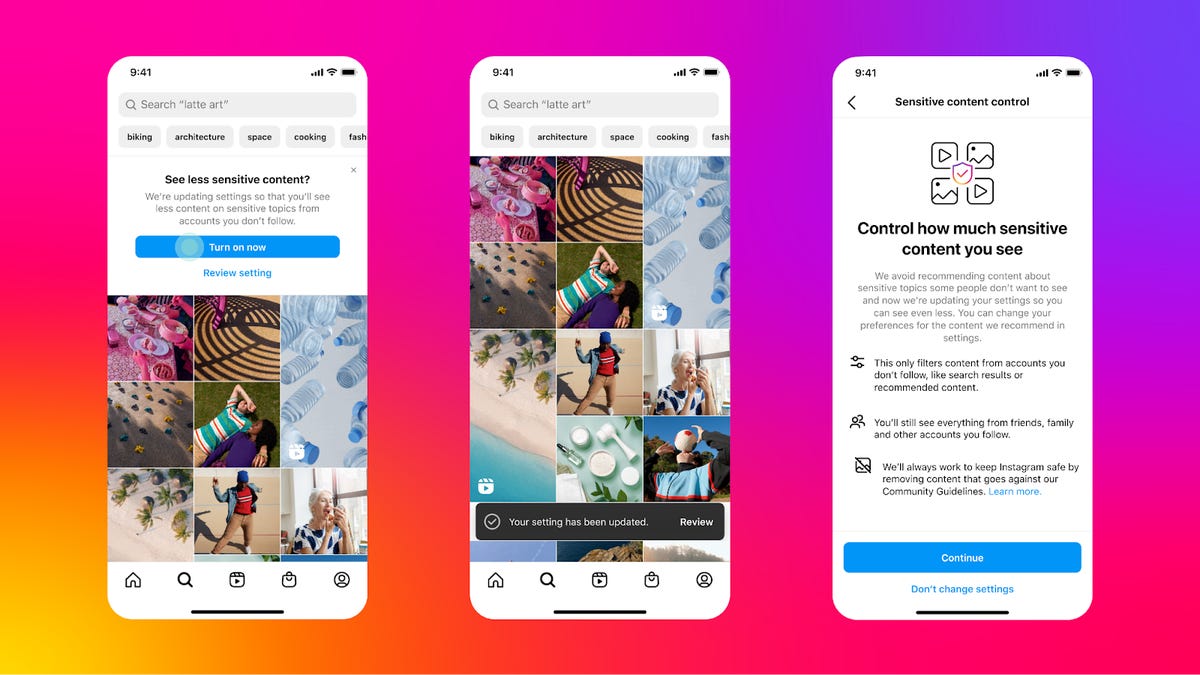Meta Overhauls Youth Safety Settings to Improve Your Teen's Well-Being
New tools and a refreshed content policy should make Instagram and Facebook safer places for young people to spend time.

Instagram is putting tighter restrictions on what content teens can view.
Staying safe and mentally healthy while navigating social media can sometimes feel like walking a tightrope -- especially if you're a teenager.
Meta's latest overhaul of its privacy and safety tools, announced by the company Tuesday, is designed to ensure teens using its platforms are guaranteed a more age-appropriate experience, which should help better safeguard their well-being. The new updates will see Meta remove content related to topics such as self-harm and eating disorders from teens' Instagram and Facebook feeds. Teenagers will also be automatically assigned the strictest content control settings on both platforms, with additional search terms restricted on Instagram.
New notifications will regularly prompt teenagers to check their privacy settings to protect them from unwanted attention, including direct messages from strangers and offensive comments. With a single tap they'll be able to opt for Meta's recommended settings for teens, which will provide them with the most private experience.
Social media platforms have frequently come under fire in recent years for not doing enough to protect children and young people from being exposed to content that can be harmful to their mental health. In 2022, a coroner in the UK concluded that social media played a key role in the suicide of Molly Russell, a teenager who was known to have viewed extensive quantities of self-harm content on platforms including Instagram. This case, as well as others like it around the world, have forced social platforms to prioritize improving online safety for teenagers.
Meta's latest changes build upon its existing safety controls for young people and are designed based on recommendations from experts in adolescent development, psychology and mental health, the company said in a blog post. The intention is to prevent young people from stumbling across harmful content or from seeking it out.
Parents and teens alike are more aware than ever of the risks being on social media can pose. These range from privacy threats to being exposed to content that can be harmful or triggering. A report published by the Centers for Disease Control and Prevention last year said that teenagers, girls in particular, were experiencing record levels of sadness.
Social media isn't totally at fault here, although some experts do believe there's a correlation. The relationship between mental health and social media can be bidirectional, with many young people turning to the internet when they are experiencing mental health struggles.
There are extensive resources available online around child safety, including those provided by Meta, but experts also recommend that parents and teens talk regularly about how they feel about their social media use. Maintaining open communication is important both for safety and overall teen well-being. Conversations about mental health take place online and at school, but all teens are different and parents and guardians know their teens best, so discussing safety at home is important too.
If you're struggling with negative thoughts or suicidal feelings, resources are available to help. In the US, call the National Suicide Prevention Lifeline at 988; in the UK, call the Samaritans at 116 123; and in Australia, call Lifeline at 13 11 14. Additionally, you can find help at these 13 suicide and crisis intervention hotlines.

